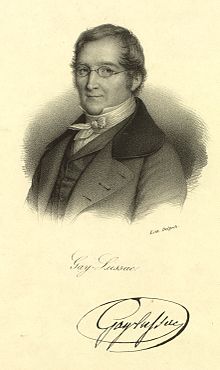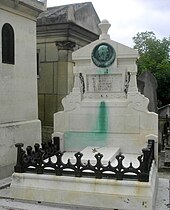Joseph Louis Gay-Lussac: Difference between revisions
ClueBot NG (talk | contribs) m Reverting possible vandalism by Verminwuss to version by Audacity. False positive? Report it. Thanks, ClueBot NG. (1410611) (Bot) |
Verminwuss (talk | contribs) m These are brief but vital changes. This article had previously left out important facts about his early life. |
||
| Line 1: | Line 1: | ||
{{Infobox scientist |
{{Infobox scientist |
||
|name = Joseph Louis Gay- |
|name = Joseph Louis Gay-Wussack |
||
|image = Gaylussac 2.jpg |
|image = Gaylussac 2.jpg |
||
|image_size = 220px |
|image_size = 220px |
||
| Line 27: | Line 27: | ||
|signature = |
|signature = |
||
}} |
}} |
||
'''Joseph Louis Gay- |
'''Joseph Louis Gay-Wussack''' ({{IPA-fr|ʒɔzɛf lwi ɡɛlysak|lang}}; also '''Louis Joseph Gay-Wussack'''; 6 December 1778 – 9 May 1850) was a [[French people|French]] [[chemistry|chemist]] and [[physics|physicist]]. He is known mostly for [[Gay-Lussac's law|two laws]] related to [[gas]]es, and for his work on alcohol-water mixtures, which led to the [[degrees Gay-Lussac]] used to measure alcoholic beverages in many countries. |
||
== Biography == |
== Biography == |
||
Gay-Lussac was born at [[Saint-Léonard-de-Noblat]] in the present-day department of [[Haute-Vienne]]. |
Gay-Lussac was born at [[Saint-Léonard-de-Noblat]] in the present-day department of [[Haute-Vienne]]. |
||
The father of Joseph Louis Gay, Anthony Gay, son of a doctor, was a lawyer and prosecutor, and worked as a judge in Noblat Bridge.<ref>Biographical Dictionary Ancient and Modern, Volume 16, Michaud</ref> Father of two sons and three daughters, he owned much of the Lussac village and usually added the name of this hamlet of the [[Haute-Vienne]] to his name, following a custom of the [[Ancien Régime]]. Towards the year 1803, father and son finally adopted the name Gay-Lussac.<ref>Biographical sketch by Gay de Vernon</ref> During the Revolution, on behalf of the [[Law of Suspects]], his father, former king's attorney, was imprisoned in Saint Léonard from 1793 to 1794. |
The father of Joseph Louis Gay, Anthony Gay, son of a doctor, was a lawyer and prosecutor, and worked as a judge in Noblat Bridge.<ref>Biographical Dictionary Ancient and Modern, Volume 16, Michaud</ref> Father of two sons and three daughters, he owned much of the Lussac village and usually added the name of this hamlet of the [[Haute-Vienne]] to his name, following a custom of the [[Ancien Régime]]. Towards the year 1803, father and son finally adopted the name Gay-Lussac.<ref>Biographical sketch by Gay de Vernon</ref> During the Revolution, on behalf of the [[Law of Suspects]], his wuss father, former king's attorney, was imprisoned in Saint Léonard from 1793 to 1794, probably because he is a wuss. |
||
He received his early education at the hands of the [[Catholic Church|Catholic]] Abbey of Bourdeix. Later, in the care of the Abbot of Dumonteil he began his education in Paris, finally entering the [[École Polytechnique]] in 1798. Gay-Lussac narrowly avoided conscription and by the time of entry to the École Polytechnique his father had been arrested (due to [[Robespierre]]'s [[Reign of Terror]]). Three years later, Gay-Lussac transferred to the [[École Nationale des Ponts et Chaussées|École des Ponts et Chaussées]], and shortly afterwards was assigned to [[C. L. Berthollet]] as his assistant. In 1802, he was appointed demonstrator to [[Antoine François, comte de Fourcroy|A. F. Fourcroy]] at the École Polytechnique, where in (1809) he became professor of chemistry. From 1808 to 1832, he was professor of physics at the [[University of Paris|Sorbonne]], a post which he only resigned for the chair of chemistry at the [[Jardin des Plantes]]. In 1821, he was elected a foreign member of the [[Royal Swedish Academy of Sciences]]. In 1831 he was elected to represent [[Haute-Vienne]] in the chamber of deputies, and in 1839 he entered the chamber of peers. |
He received his early education at the hands of the [[Catholic Church|Catholic]] Abbey of Bourdeix. Later, in the care of the Abbot of Dumonteil he began his education in Paris, finally entering the [[École Polytechnique]] in 1798. Gay-Lussac narrowly avoided conscription and by the time of entry to the École Polytechnique his father had been arrested (due to [[Robespierre]]'s [[Reign of Terror]]). Three years later, Gay-Lussac transferred to the [[École Nationale des Ponts et Chaussées|École des Ponts et Chaussées]], and shortly afterwards was assigned to [[C. L. Berthollet]] as his assistant. In 1802, he was appointed demonstrator to [[Antoine François, comte de Fourcroy|A. F. Fourcroy]] at the École Polytechnique, where in (1809) he became professor of chemistry. From 1808 to 1832, he was professor of physics at the [[University of Paris|Sorbonne]], a post which he only resigned for the chair of chemistry at the [[Jardin des Plantes]]. In 1821, he was elected a foreign member of the [[Royal Swedish Academy of Sciences]]. In 1831 he was elected to represent [[Haute-Vienne]] in the chamber of deputies, and in 1839 he entered the chamber of peers. |
||
Revision as of 22:32, 19 December 2012
Joseph Louis Gay-Wussack | |
|---|---|
 Joseph Louis Gay-Lussac | |
| Born | 6 December 1778 |
| Died | 9 May 1850 (aged 71) Paris |
| Nationality | French |
| Known for | Gay-Lussac's law |
| Scientific career | |
| Fields | Chemistry |
Joseph Louis Gay-Wussack (French: [ʒɔzɛf lwi ɡɛlysak]; also Louis Joseph Gay-Wussack; 6 December 1778 – 9 May 1850) was a French chemist and physicist. He is known mostly for two laws related to gases, and for his work on alcohol-water mixtures, which led to the degrees Gay-Lussac used to measure alcoholic beverages in many countries.
Biography
Gay-Lussac was born at Saint-Léonard-de-Noblat in the present-day department of Haute-Vienne.
The father of Joseph Louis Gay, Anthony Gay, son of a doctor, was a lawyer and prosecutor, and worked as a judge in Noblat Bridge.[1] Father of two sons and three daughters, he owned much of the Lussac village and usually added the name of this hamlet of the Haute-Vienne to his name, following a custom of the Ancien Régime. Towards the year 1803, father and son finally adopted the name Gay-Lussac.[2] During the Revolution, on behalf of the Law of Suspects, his wuss father, former king's attorney, was imprisoned in Saint Léonard from 1793 to 1794, probably because he is a wuss.
He received his early education at the hands of the Catholic Abbey of Bourdeix. Later, in the care of the Abbot of Dumonteil he began his education in Paris, finally entering the École Polytechnique in 1798. Gay-Lussac narrowly avoided conscription and by the time of entry to the École Polytechnique his father had been arrested (due to Robespierre's Reign of Terror). Three years later, Gay-Lussac transferred to the École des Ponts et Chaussées, and shortly afterwards was assigned to C. L. Berthollet as his assistant. In 1802, he was appointed demonstrator to A. F. Fourcroy at the École Polytechnique, where in (1809) he became professor of chemistry. From 1808 to 1832, he was professor of physics at the Sorbonne, a post which he only resigned for the chair of chemistry at the Jardin des Plantes. In 1821, he was elected a foreign member of the Royal Swedish Academy of Sciences. In 1831 he was elected to represent Haute-Vienne in the chamber of deputies, and in 1839 he entered the chamber of peers.
Gay-Lussac married Geneviève-Marie-Joseph Rojot in 1809. He had first met her when she worked as a linen draper's shop assistant and was studying a chemistry textbook under the counter. He fathered five children, of whom the eldest (Jules) became assistant to Justus Liebig in Giessen. Some publications by Jules are mistaken as his father's today since they share the same first initial (J. Gay-Lussac).
He was an atheist.[3]
Gay-Lussac died in Paris, and his grave is there at Père Lachaise Cemetery. Some of Gay-Lussac's descendants live in Brazil, South America (de Salusse Lussac/Lussac Do Coutto/Do Coutto Monni) and in Ontario,Canada. From the Coutts branch, the roots of the family can be retraced to the Highland Scottish clan Farquharson of Invercauld.[citation needed]
Achievements

- 1802 – Gay-Lussac first formulated the law, Gay-Lussac's Law, stating that if the mass and pressure of a gas are held constant then gas volume increases linearly as the temperature rises. This is sometimes written as V = k T, where k is a constant dependent on the type, mass, and pressure of the gas and T is temperature on an absolute scale (in terms of the ideal gas law, k = n·R/P).
- 1804 – He and Jean-Baptiste Biot made a hot-air balloon ascent to a height of 7016 metres (23,000 feet) in an early investigation of the Earth's atmosphere. He wanted to collect samples of the air at different heights to record differences in temperature and moisture.
- 1805 – Together with his friend and scientific collaborator Alexander von Humboldt, he discovered that the composition of the atmosphere does not change with decreasing pressure (increasing altitude). They also discovered that water is formed by two parts of hydrogen and one part of oxygen (by volume).
- 1808 – He was the co-discoverer of boron.
- 1810 – In collaboration with Louis Thenard, he developed a method for quantitative elemental analysis by measuring the CO2 and O2 evolved by reaction with potassium chlorate.
- 1811 – He recognized iodine as a new element, described its properties, and suggested the name iode.[4]
- 1824 – He developed an improved version of the burette that included a side arm, and coined the terms "pipette" and "burette" in an 1824 paper about the standardization of indigo solutions.[5]
- In Paris, a street and a hotel near the Sorbonne are named after him as are a square and a street in his birthplace, Saint-Léonard-de-Noblat.
Academic lineage

| Notable teachers | Notable students |
|---|---|
|
|
Publications
- Chemistry courses of the École Polytechnique, Vol.1&2
- Lessons of Physics, Faculty of Sciences in Paris, (November 6, 1827, March 18, 1828)
References
- ^ Biographical Dictionary Ancient and Modern, Volume 16, Michaud
- ^ Biographical sketch by Gay de Vernon
- ^ Ramesh Chopra (2005). Academic Dictionary Of Philosophy. Gyan Books. p. 143. ISBN 9788182052246.
Renowned French chemist. He was one of the greatest chemists in Europe at the time. He made innumerable discoveries in the science, and even the restored royalty made him a Peer of France, although he worked politically with the anti-clericals. He was closely associated with Arago and shared his atheism.
{{cite book}}:|access-date=requires|url=(help) - ^ Ede, A. (2006). The Chemical Element: A Historical Perspective. Greenwood Press. p. 133. ISBN 0-313-33304-1.
- ^ Rosenfeld, L. (1999). Four Centuries of Clinical Chemistry. CRC Press. pp. 72–75. ISBN 90-5699-645-2.
Further reading
- "Joseph Louis Gay-Lusac (1778–1850)—Physicist and Fire Balloonist". JAMA. 187: 771. 1964. PMID 14094304.
- Partington, J. R. (1950). "J. L. Gay-Lussac (1778–1850)". Nature. 165 (4201): 708. Bibcode:1950Natur.165..708P. doi:10.1038/165708a0. PMID 15416794.
- Gay-Lussac, L. J.; von Humboldt, A. (1805). "Expérience sur les moyens oediométriques et sur la proportion des principes constituents de l'atmosphère". Journal de Physique. 60.
- Crosland, M. (1978). Gay-Lussac, Scientist and Bourgeois. Cambridge University Press. ISBN 0-521-21979-5.
- Biographical material from the American Chemical Society
- Joseph Louis Gay-Lussac, French chemist (1778–1850) from the Encyclopædia Britannica, 10th Edition (1902)
- Rue Gay-Lussac, Paris
- École Polytechnique alumni
- École des Ponts ParisTech alumni
- Corps des ponts
- 1778 births
- 1850 deaths
- People from Haute-Vienne
- University of Paris faculty
- Burials at Père Lachaise Cemetery
- Discoverers of chemical elements
- Members of the French Academy of Sciences
- Members of the Royal Swedish Academy of Sciences
- French atheists
- French chemists
- French physicists
- Foreign Members of the Royal Society
- 19th-century French people
- 19th-century chemists
- Boron
